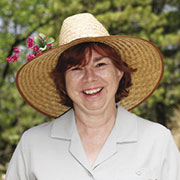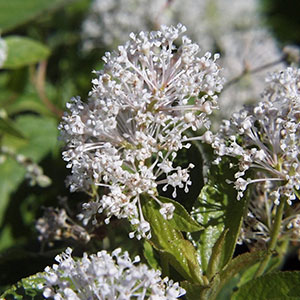Gardening Q&A
-
As a California Bountiful reader, you have the opportunity to get your seasonal gardening questions answered by gardening expert Pat Rubin. Here are a few questions from other readers.
Hi Pat,
I have a 6-year-old dwarf tangerine tree. It produced more than 200 delicious tangerines this winter. However, the leaves are now turning yellow and many are dropping. This has not happened before. I did have a problem with a tunneling animal for the last two months. Is there a connection or is it just a lack of nutrients? I have never fertilized the tree.
Dennis
Hi Dennis,
Based on what you've said, I'd put the blame squarely on the tunneling critters. Since nothing else has changed as far as the care of the tree, that seems the most likely culprit. Gophers and moles are tough to control. The gophers eat plant roots while the moles are looking for grubs. However, the moles disturb plant roots along the way.
I would give the plant a light dose of fertilizer, and by light I mean half of what the box recommends, every few weeks to at least give it a boost while dealing with this problem. Also try patting the soil back down if it is the gopher hills you are seeing on top of the ground. If it's moles, you'll see the ridges on top of the ground left by the tunneling.
I would also go the UC Cooperative Extension website and see what they say about gophers and moles. Here are a few to look at:
cesonoma.ucdavis.edu
www.ipm.ucdavis.edu
ucipm.ucdavis.eduGood luck,
PatWhat is an easy thing for me to do to make sure my plants can survive on little water this summer?
The easiest, fastest and probably most effective measure to protect plants from summer heat—whether during a drought or a normal summer—is mulch. Add a 3- or 4-inch layer of chipped bark or leaves to all your flowerbeds, and I guarantee your plants will use less water. The reason is the mulch protects the soil, keeps it from baking and hardening in the sun, and keeps more moisture in the ground. Mulch also gives the garden a tidy appearance and prevents weeds from sprouting since they're denied sun.My cannas bloom beautifully, but the flowers don't last a long time, and after they're done the plants look a little messy. Can I cut them back or do I have to wait until the fall?
I used to think I had to leave the cannas stems alone until it was time to cut them back each fall, but learned that if I cut the stem that is done flowering to the ground, the roots will send up others and I'll get another flush of bloom. This works especially well if you have a big clump of cannas because you'll always have plenty of mature stems and ones about to bloom.I'm having a debate with a friend who says my lawn will need less water if I let it stay taller. I like to keep it cut short. Who is right?
Your friend is correct. Raising the blade on the lawnmower at or near its highest setting is best for water conservation. The blades of grass act as a living mulch to shade the soil and each other, so a lawn allowed to grow taller requires less water.About Pat Rubin, California Bountiful's gardening expert

Pat RubinFor Pat Rubin, gardening is more than just dirt and plants. "It's about history, romance, adventure and people," she says. "And it should be fun."
California Bountiful's gardening columnist has lived and chronicled this fun, hands-in-the-dirt approach for years—and for additional publications including Fine Gardening, Pacific Horticulture, Christian Science Monitor, Family Circle and The Sacramento Bee. Pat has also volunteered as a Master Gardener, speaks to garden clubs and appears regularly on gardening radio shows.
Need gardening advice? Ask the expert!
Send your questions to gardening@californiabountiful.com
-
Dear Pat,
I have a pine tree up on a very steep hill in my backyard. It is very hard to reach and to work up on the hill. I have gotten up there and planted some plants, but it seems like the plants die off. What can I plant under the pine tree that will survive? I have rosemary under it right now, but several of the plants have died already. I was thinking of maybe doing something with hydroseeding due to the difficultly of planting. Any ideas would be helpful. Thanks.
Jan
Hi Jan,

CeanothusHillsides are always tough places to garden. I speak from experience! Whenever I plant something on a slope, I try to make the planting hole as level as possible, and then dig a small trench above the plant that I believe will capture the water and direct it down toward the plant instead of letting it roll down the hillside.
You mentioned rosemary and said it was working out for you. Try similar plants: I'd start with ceanothus or cotoneaster. Ceanothus makes gorgeous blue flowers this time of year, and the leaves are beautiful year-round. Cotoneaster has beautiful fall color—orange or red berries beloved by birds, and shiny, brighter green leaves. Very nice. Choose ones that spread outwards rather than grow upwards. The ceanothus with the small, dark green sort of crinkled leaves are more drought tolerant that those with bigger leaves.
Lastly, add lots of mulch. It will protect the soil, keep it soft and friable, conserve moisture, deter weeds—in a nutshell, mulch is perfect for just about anything that ails a garden! It also gives the beds a clean, manicured look.
Let me know if this helps.
Pat
Dear Pat,
I'm looking for Belgian tomatoes in Sacramento. Any leads on where I could purchase a few plants for my garden? I grew a few years ago and had so much fun with them. Thanks.
Hello!
I don't know of any local nursery that sells Belgian tomatoes, but did find some online seed sources, including Burpee. If you do a search for Belgian tomatoes, you'll get plenty of hits on growing them and on places to buy seed.
Most gardeners start tomato seeds in February so they get a quick, big start on the season. But it isn't too late to order seeds and get them going. We have such a long growing season in the Sacramento area that you won't be too far behind.
The only other suggestion is to call some of the local nurseries and see whether they sell that variety. It is similar to Brandywine, so if you can't find the Belgian, try Brandywine.
Pat
I just moved to the country where the deer come into the garden. What can I plant besides rosemary and lavender that they won't eat? Help!
When I first moved into an area with lots of deer, I, too, thought I'd have a garden of nothing but rosemary and lavender, but I've discovered many, many plants they don't ever eat. My tried-and-true list includes magnolias, osmanthus, New Zealand flax, hellebores, hardy geraniums, red-hot pokers, daffodils, culinary sage, Santolina, manzanita, miscanthus (and most ornamental grasses) and irises. They also avoid the bamboo. I plant the clumping bamboo in the ground, but keep the varieties that spread in a large pot.
Last year my fruit trees produced a lot of fruit, but the fruits were very small. Do the trees need more water to make larger fruits?
Fruit trees produce plenty of blooms and fruit in the hope some of it will mature and produce seed. That isn't our goal for the tree. We want plump apples, pears and peaches. You need to thin the fruit several times during the early spring. Snip away the smallest fruits in each clump until you've thinned the fruit to one every 4 to 6 inches.I planted marigolds and the next morning there was nothing left. The leaves looked like they'd been stripped. What happened?
My money is on earwigs. They love newly planted marigolds. In fact, I think it is one of their favorites. Go out in the garden about 10 p.m. and take a look around. Chances are you'll also find them under the lettuce leaves. You can handpick them or use bait specially formulated for killing them. There are pet- and child-safe baits you can use. Check your local nursery.About Pat Rubin, California Bountiful's gardening expert

Pat RubinFor Pat Rubin, gardening is more than just dirt and plants. "It's about history, romance, adventure and people," she says. "And it should be fun."
California Bountiful's gardening columnist has lived and chronicled this fun, hands-in-the-dirt approach for years—and for additional publications including Fine Gardening, Pacific Horticulture, Christian Science Monitor, Family Circle and The Sacramento Bee. Pat has also volunteered as a Master Gardener, speaks to garden clubs and appears regularly on gardening radio shows.
Need gardening advice? Ask the expert!
Send your questions to gardening@californiabountiful.com
-
As a California Bountiful reader, you have the opportunity to get your seasonal gardening questions answered by gardening expert Pat Rubin. Here are a few questions from other readers.
Sometimes we go long spells without rain. Should I water the garden?
Yes, if the garden goes more than a week or 10 days without water, give it a drink. Potted plants need to be watered more often since the water drains away so quickly, and the only protection the soil and roots have is the thickness of the pot. Don't forget pots under eaves or against the sides of the house probably don't get any water from the rains, so it's up to you to keep them alive.My ornamental grasses are a gorgeous golden color and I love looking at them, but I already see bits of new green growth coming up. Should I cut them back?
Ornamental grasses really come into their own in fall and winter when their foliage turns a beautiful golden color, and they look amazing against the rain and snow. But when you see green growth, that means it's time to cut away the old growth and let the new take over. If you don't cut it now, you'll be cutting away the tops of the new growth when you prune. Some winter tasks can wait, but this cannot.I want to get a head start on the vegetable garden and was told to plant tomato seeds now. Isn't it too cold outside for that?
Yes and no. If you've grown tomatoes for any length of time, you know you'll get volunteer seedlings in the garden quite early in the season. I always figure Mother Nature knows what she's doing when that happens. Of course, you don't know if these seeds will be what you had last year; they may have crossed with another tomato, or if they were hybrids, they will revert back to one of the parents used in the cross.The best way to plant tomato seeds now is indoors. If you don't have lights to put them under, put them on a sunny windowsill once the seeds have germinated. Not enough light causes them to get leggy and spindly. Growers who routinely start tomato seeds in February use heat mats and grow lights to get them off to a good start. It's not imperative you do this, but it makes the job easier.
About Pat Rubin, California Bountiful's gardening expert

Pat RubinFor Pat Rubin, gardening is more than just dirt and plants. "It's about history, romance, adventure and people," she says. "And it should be fun."
California Bountiful's gardening columnist has lived and chronicled this fun, hands-in-the-dirt approach for years—and for additional publications including Fine Gardening, Pacific Horticulture, Christian Science Monitor, Family Circle and The Sacramento Bee. Pat has also volunteered as a Master Gardener, speaks to garden clubs and appears regularly on gardening radio shows.
Need gardening advice? Ask the expert!
Send your questions to gardening@californiabountiful.com

